Toshiba TV 27A33 User Manual
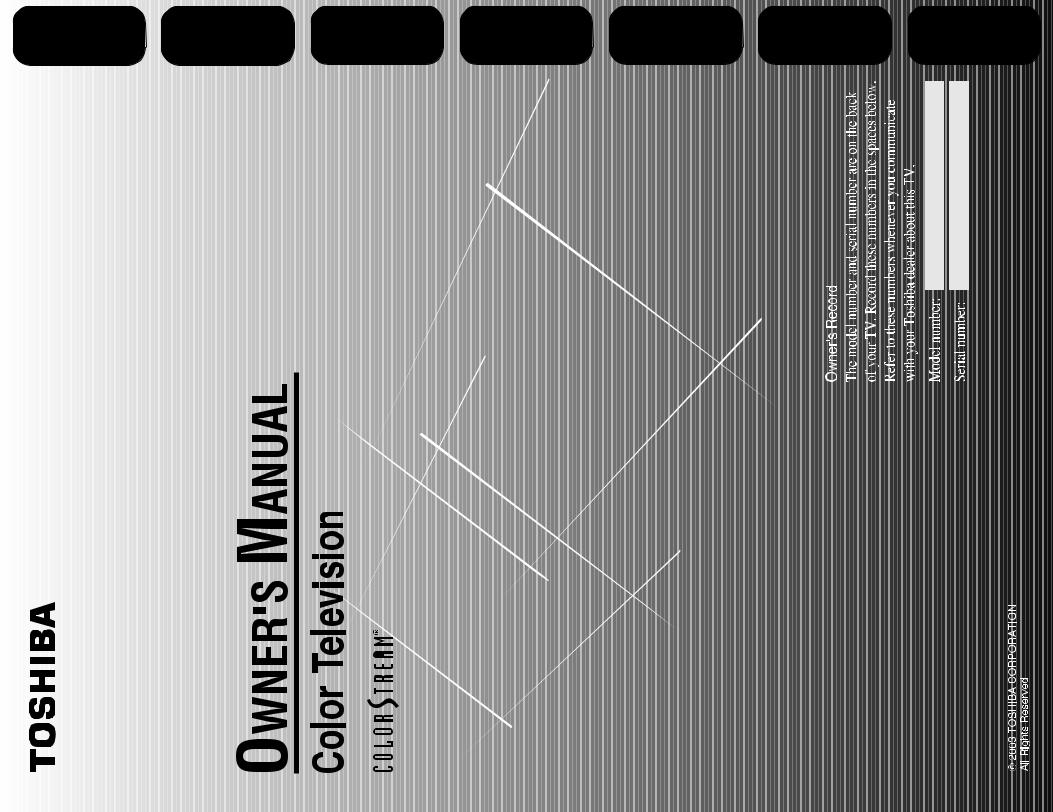
Important |
Welcome to |
Connecting |
Using the |
Setting up |
Using the TV’s |
Appendix |
|
Safeguards |
Toshiba |
your TV |
Remote Control |
your TV |
Features |
||
|
|||||||
|
|
|
|
|
|
27A33 |
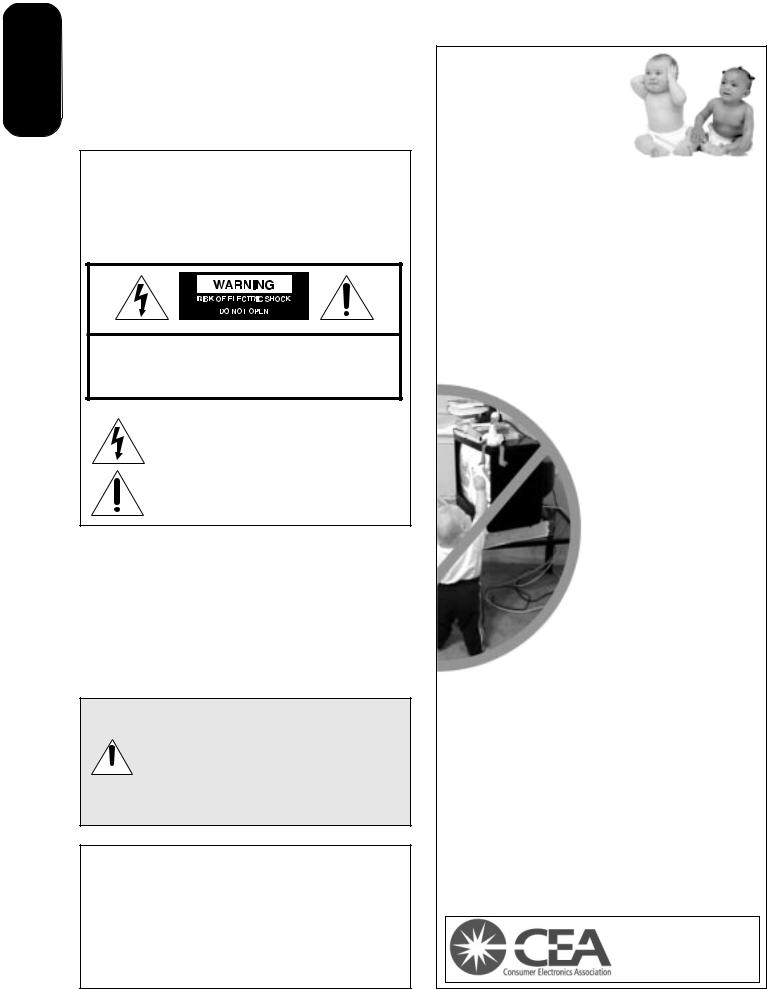
Important |
Safeguards |
Dear Customer,
Thank you for purchasing this Toshiba TV. This manual will help you use the many exciting features of your new TV.
Before operating the TV, please read this manual completely, and keep it nearby for future reference.
Safety cautions
WARNING
TO REDUCE THE RISK OF FIRE OR ELECTRIC SHOCK, DO NOT EXPOSE THIS APPLIANCE TO RAIN OR MOISTURE.
WARNING: TO REDUCE THE RISK OF ELECTRIC SHOCK, DO NOT REMOVE COVER (OR BACK). NO USER-SERVICEABLE PARTS INSIDE. REFER SERVICING TO QUALIFIED SERVICE PERSONNEL.
The lightning symbol in the triangle tells you that the voltage inside this product may be strong enough to cause an electric shock. DO NOT TRY TO SERVICE THIS PRODUCT YOURSELF.
The exclamation mark in the triangle tells you that important operating and maintenance instructions follow this symbol.
NOTE TO CATV INSTALLERS IN THE USA
This is a reminder to call the CATV system installer’s attention to Article 820-40 of the NEC, which provides guidelines for proper grounding and, in particular, specifies that the cable ground shall be connected to the grounding system of the building, as close to the point of cable entry as practical. For additional antenna grounding information, see items 25 and 26 on page 4.
NOTICE OF POSSIBLE TV STAND INSTABILITY
DANGER: RISK OF SERIOUS PERSONAL INJURY OR DEATH! Use this TV with
 the TOSHIBA TV stand recommended in the “Specifications” section only. Use with other stands may result in instability, causing possible injury or death.
the TOSHIBA TV stand recommended in the “Specifications” section only. Use with other stands may result in instability, causing possible injury or death.
NOTICE OF POSSIBLE ADVERSE EFFECTS
ON TV PICTURE TUBE
If a fixed (non-moving) pattern remains on the TV screen for long periods of time, the image can become permanently engrained in the picture tube. This type of damage is NOT COVERED BY YOUR WARRANTY.
See item 33 on page 4.
0303
22
Child Safety
It Makes A Difference
Where Your TV Stands
Congratulations on your purchase! As you enjoy your new TV, keep these safety tips in mind:
The Issue
æIf you are like most consumers, you have a TV in your home. Many homes, in fact, have more than one TV.
æThe home theater entertainment experience is a growing trend, and larger TVs are popular purchases; however, they are not always supported on the proper TV stands.
æSometimes TVs are improperly secured or inappropriately situated on dressers, bookcases, shelves, desks, audio speakers, chests, or carts. As a result, TVs may fall over, causing unnecessary injury.
Cares!
consumer electronics industry committed to making home entertainment enjoyable and safe. æ The Consumer Electronics
Association formed the Home Entertainment Support Safety Committee, comprised of TV and consumer electronics furniture manufacturers, to advocate children’s safety and educate consumers and their families about television safety.
Into Safety
does NOT fit all! Use appropriate enough to support the weight of your
TV (and other electronic components).
æUse appropriate angle braces, straps, and anchors to secure your furniture to the wall (but never screw anything directly into the TV).
æCarefully read and understand the other enclosed instructions for proper use of this product.
æDo not allow children to climb on or play with furniture and TVs.
æAvoid placing any item on top of your TV (such as a VCR, remote control, or toy) that a curious child may reach for.
æRemember that children can become excited while watching a program and can potentially push or pull a TV over.
æShare our safety message about this hidden hazard of the home with your family and friends. Thank you!
2500 Wilson Blvd. Arlington, VA 22201 U.S.A.
Tel. 703-907-7600 Fax 703-907-7690 www.CE.org
CEA is the Sponsor, Producer and Manager of the International CES®
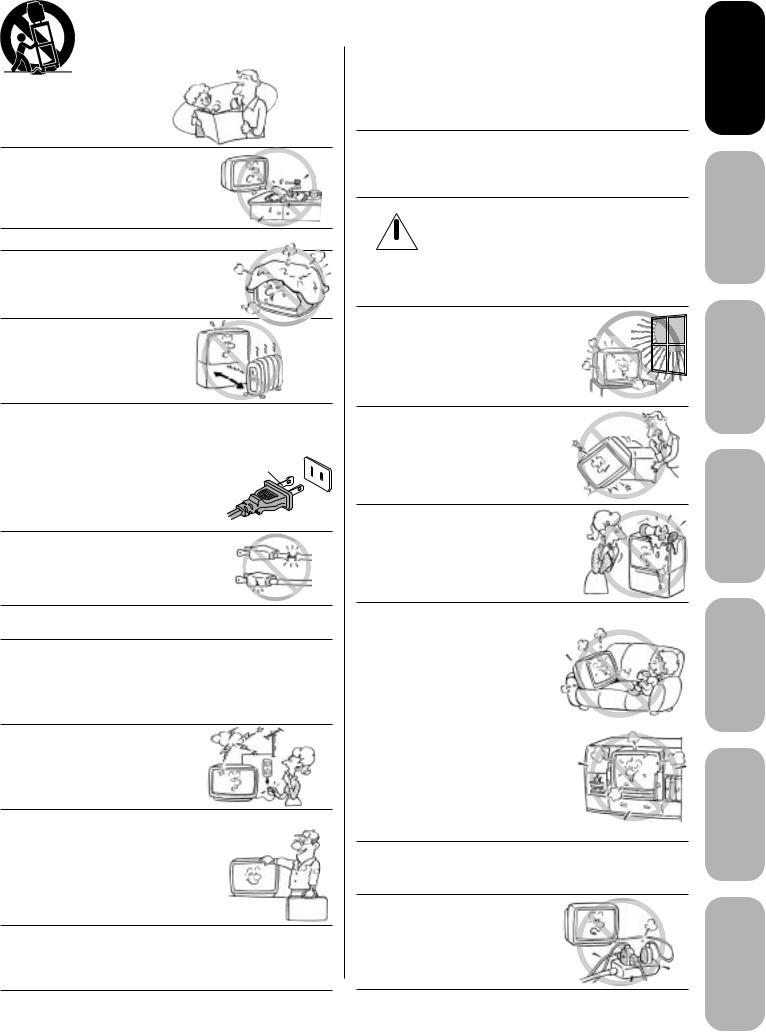
Important Safety Instructions
1)Read these instructions.
2)Keep these instructions.
3)Heed all warnings.
4)Follow all instructions.
5)Do not use this apparatus near water.
6)Clean only with a dry cloth.
7)Do not block any ventilation openings. Install in accordance with the manufacturer’s instructions.
8)Do not install near any heat sources such as radiators, heat registers, stoves, or other apparatus (including amplifiers) that produce heat.
9)Do not defeat the safety purpose of the polarized or grounding type plug. A polarized plug has two blades with one wider than the other. A grounding type plug has
two blades and a third grounding prong. The wide blade or the third prong are provided for your safety.
If the provided plug does not fit into your outlet, consult an electrician
for replacement of the obsolete outlet.
10)Protect the power cord from being walked on or pinched, particularly at plugs, convenience receptacles, and the point where it exits the apparatus.
11)Only use attachments/accessories specified by the manufacturer.
12)Use only with the cart, stand, tripod, bracket, or table specified by the manufacturer, or sold with the apparatus. When a cart is used, use caution when moving the cart/apparatus combination to avoid injury from tip-over.
13) Unplug this apparatus during lightning storms or when unused for long periods
of time.
14)Refer all servicing to qualified service personnel.
Servicing is required when the apparatus damaged in any way, such as power cord or plug is damaged, liquid has been spilled or objects have fallen into
the apparatus, the apparatus has been exposed to rain or moisture, does not operate normally, or has been dropped.
15)CAUTION: To reduce the risk of electric shock, do not use the polarized plug with an extension cord, receptacle, or other outlet unless the blades can be inserted completely to prevent blade exposure.
Installation, Care, and Service
Installation
Follow these recommendations and precautions and heed all warnings when installing your TV:
16)Never modify this equipment. Changes or modifications may void: a) the warranty, and b) the user’s authority to operate this equipment under the rules of the Federal Communications Commission.
17)DANGER: RISK OF SERIOUS PERSONAL INJURY, DEATH, OR EQUIPMENT
 DAMAGE! Never place the TV on an unstable cart, stand, or table. The TV may fall, causing serious personal injury, death, or serious damage to the TV.
DAMAGE! Never place the TV on an unstable cart, stand, or table. The TV may fall, causing serious personal injury, death, or serious damage to the TV.
18) Never place or store the TV in direct sunlight; hot, humid areas; areas subject to excessive dust or vibration; or locations with temperatures at or below 41°F (5°C).
19)Always place the TV on the floor
or a sturdy, level, stable surface that can support the weight of the unit.
20)Never place items such as vases, aquariums, or candles on top of the TV
21)Never block or cover the slots or openings in the TV cabinet back, bottom, and sides. Never place the TV:
•on a bed, sofa, rug, or similar surface;
•too close to drapes, curtains, or walls; or
•in a confined space such as a bookcase, built-in cabinet, or any other place with poor ventilation.
The slots and openings are provided to protect the TV from overheating and to help maintain reliable operation of the TV.
22)Never allow anything to rest on or roll over the power cord, and never place the TV where the power cord is subject to wear or abuse.
23)Never overload wall outlets and extension cords.
0303
33
Safeguards |
Important |
to Welcome
Toshiba
Connecting TV your
the Using
Control Remote
up Setting TV your
TV’s the Using
Features
Appendix

Important |
Safeguards |
120V AC?
24)Always operate this equipment from a 120V AC, 60 Hz power source only.
25)Always make sure the antenna system is properly grounded to provide adequate protection against voltage surges and built-up static charges (see Section 810 of the National Electric Code).
Ground clamp
Electric service equipment
Ground clamps 
Antenna lead-in wire
Antenna discharge unit (NEC Section 810-20)
Grounding conductors (NEC Section 810-21)
Power service grounding
electrode system (NEC Art 250 Part H)
26)DANGER: RISK OF SERIOUS PERSONAL
INJURY OR DEATH!
 • Use extreme care to make sure you are never in a position where your body (or any item you are in contact with, such as a ladder or screwdriver) can accidentally touch overhead power lines. Never locate the antenna near overhead power lines or other electrical circuits.
• Use extreme care to make sure you are never in a position where your body (or any item you are in contact with, such as a ladder or screwdriver) can accidentally touch overhead power lines. Never locate the antenna near overhead power lines or other electrical circuits.
• Never attempt to install any of the following during lightning activity:
a) an antenna system; or b) cables, wires, or any home theater component connected to an antenna or phone system.
Care
For better performance and safer operation of your TOSHIBA TV, follow these recommendations and precautions:
27)Always sit approximately 10–25 feet away from the TV and as directly in front of it as possible. The picture can appear dull if you sit too far to the left or right of the TV, or if sunlight or room lights reflect on the screen. Turn the TV off to check for reflections on the screen, and then remove the source of reflections while viewing the TV.
28)Always unplug the TV before cleaning. Never use liquid or aerosol cleaners.
29)WARNING: RISK OF ELECTRIC SHOCK!
Never spill liquids or push objects of any kind
into the TV cabinet slots.
30)[This item applies to projection TVs only.] If the air temperature rises suddenly (for example, when the TV is first delivered), condensation may form on the lenses. This can make the picture appear distorted or the color appear faded. If this happens, turn off the TV for 6 to 7 hours to allow the condensation to evaporate.
31)For added protection of your TV from lightning and power surges, always unplug the power cord and disconnect the antenna from the TV if you leave the TV unattended or unused for long periods of time.
32)During normal use, the TV may make occasional snapping or popping sounds. This is normal, especially when the unit is being turned on or off. If these sounds become frequent or continuous, unplug the power
and contact a Toshiba Authorized Service Center.
33)Possible Adverse Effects on TV Picture Tube: If a fixed (non-moving) pattern remains on the TV screen for long periods of time, the image can become permanently engrained in the picture tube and cause subtle but permanent ghost images. This type of damage is NOT COVERED BY YOUR WARRANTY. Never leave your TV on for long periods of time while it is displaying the following formats or images:
•Fixed Images, such as PIP/POP windows, stock tickers, video game patterns, TV station logos, and websites.
•Special Formats that do not use the entire screen. For example, viewing letterbox style (16:9) media on a normal (4:3) display (gray bars at top and bottom of screen); or viewing normal style (4:3) media on a widescreen (16:9) display (gray bars on left and right sides of screen).
Service
34)WARNING: RISK OF
SHOCK! Never attempt to TV yourself. Opening and
removing the covers may expose you to dangerous voltage or other hazards. Refer all servicing to a Toshiba Authorized Service Center.
QUALIFIED
SERVICE
TECHNICIAN
35)If you have the TV serviced:
•Ask the service technician to use only replacement parts specified by the manufacturer.
•Upon completion of service, ask the service technician to perform routine safety checks to determine that the TV is in safe operating condition.
36)When the TV reaches the end of its useful life, ask a qualified service technician to properly dispose of the TV. Improper disposal may result in a picture tube implosion and possible personal injury.
0303
44

Important Safety Information .......................................................................................... |
2-4 |
Welcome to Toshiba............................................................................................................ |
6 |
Exploring your new TV ................................................................................................................................. |
6 |
Selecting a location for the TV ..................................................................................................................... |
6 |
Connecting your TV ............................................................................................................ |
7 |
Connecting a VCR ....................................................................................................................................... |
7 |
Connecting a cable converter box ............................................................................................................... |
8 |
Connecting a DVD player/satellite receiver and a VCR ............................................................................... |
9 |
Connecting a DVD player with ColorStream® (component video) and a VCR ............................................ |
9 |
Connecting two VCRs ................................................................................................................................ |
10 |
Connecting a camcorder ........................................................................................................................... |
10 |
Connecting an audio amplifier ................................................................................................................... |
10 |
Using the remote control .................................................................................................. |
11 |
Installing the remote control batteries ....................................................................................................... |
11 |
Learning about the remote control ............................................................................................................ |
11 |
Setting up your TV ............................................................................................................. |
12 |
Changing the on-screen display language ................................................................................................ |
12 |
Adding channels to the TV’s memory ........................................................................................................ |
13 |
Programming channels automatically ................................................................................................ |
13 |
Adding and erasing channels manually ............................................................................................. |
13 |
Changing channels .................................................................................................................................... |
13 |
Using the TV’s features ..................................................................................................... |
14 |
Adjusting the channel settings ................................................................................................................... |
14 |
Switching between two channels ....................................................................................................... |
14 |
Programming your favorite channels .................................................................................................. |
14 |
Using theV-Chip (parental control) feature (U.S. V-Chip system only) ...................................................... |
15 |
Selecting a PIN code .......................................................................................................................... |
15 |
Blocking programs by ratings ............................................................................................................. |
16 |
Blocking unrated movies or programs ................................................................................................ |
19 |
Using the LOCK menu ............................................................................................................................... |
19 |
Locking channels ................................................................................................................................ |
19 |
Locking video input ............................................................................................................................. |
20 |
Setting the game timer .............................................................................................................................. |
20 |
Labeling channels ...................................................................................................................................... |
21 |
Setting the clock ........................................................................................................................................ |
22 |
Setting the ON/OFF timer .......................................................................................................................... |
22 |
Setting the on timer ............................................................................................................................ |
22 |
Setting the off timer ............................................................................................................................ |
23 |
Adjusting the picture quality ...................................................................................................................... |
24 |
Watching video input ................................................................................................................................. |
24 |
Selecting the ColorStream® mode ............................................................................................................. |
24 |
Displaying on-screen information .............................................................................................................. |
24 |
Setting the sleep timer ............................................................................................................................... |
25 |
Using the closed caption feature ............................................................................................................... |
25 |
Adjusting the sound ................................................................................................................................... |
26 |
Muting the sound ................................................................................................................................ |
26 |
Selecting stereo/SAP broadcasts ....................................................................................................... |
26 |
Adjusting the sound quality ................................................................................................................ |
26 |
Using the surround sound feature ...................................................................................................... |
27 |
Using the StableSound® feature ......................................................................................................... |
27 |
Auto power off ............................................................................................................................................ |
27 |
Understanding the Power Return feature .................................................................................................. |
27 |
Appendix ............................................................................................................................ |
28 |
Troubleshooting ......................................................................................................................................... |
28 |
Specifications ............................................................................................................................................. |
29 |
Limited United States Warranty ................................................................................................................. |
30 |
Limited Canada Warranty .......................................................................................................................... |
31 |
Safeguards |
Important |
to Welcome
Toshiba
Connecting TV your
the Using
Control Remote
up Setting TV your
TV’s the Using
Features
5
Appendix
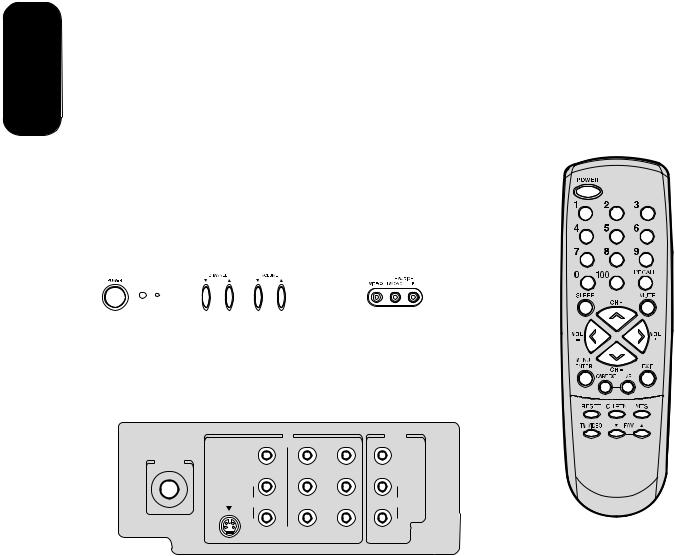
Toshiba
Welcome to
Welcome to Toshiba
Congratulations! You have purchased one of the finest color TVs on the market. The goal of this manual is to guide you through setting up and operating your Toshiba TV as quickly as possible.
You may need to purchase other audio or video cables to connect your equipment. See “Connecting your TV” on page 7 for more information.
Please read all the safety and operating instructions carefully before you begin.
Exploring your new TV
You can operate your TV by using the buttons on the front panel or the remote control. The front and back panels provide all the inputs you will need to connect other equipment to your TV.
|
Power indicator |
Channel ▼/▲ |
|||||||||||||
Remote sensor |
|
|
|
|
Volume ▼/▲ |
||||||||||
|
Power |
|
|
|
|
|
|
|
|
Audio (L/R)/Video In |
|||||
|
|
|
|
|
|
|
|
||||||||
|
|
|
|
|
|
|
|
|
|
|
|
|
|
||
|
|
|
|
|
|
|
|
|
|
|
|
|
|
||
|
|
|
|
|
|
|
|
|
|
|
|
|
|
|
|
|
|
|
|
|
|
|
|
|
|
|
|
|
|
|
|
|
|
|
|
|
|
|
|
|
|
|
|
|
|
|
|
|
|
|
|
|
|
|
|
|
|
|
|
|
|
|
|
|
|
|
|
|
|
|
|
|
|
|
|
|
|
|
|
|
|
|
|
|
|
|
|
|
|
|
|
|
|
|
|
TV front panel
IN |
OUT |
|
Y |
VIDEO |
VIDEO |
ANT (75Ω) |
|
PB |
CT-844 |
L/MONO |
|
L/MONO |
|
S-VIDEO |
AUDIO |
PR |
AUDIO |
|
|
|
|
|
R |
|
R |
|
VIDEO 1 |
VIDEO 2 |
|
TV back panel
Selecting a location for the TV
•Place the TV on the floor or on a sturdy platform in a location where light does not directly hit the screen.
•Place the TV far enough from the walls to allow proper ventilation. Inadequate ventilation may cause overheating, which may damage the TV.
6
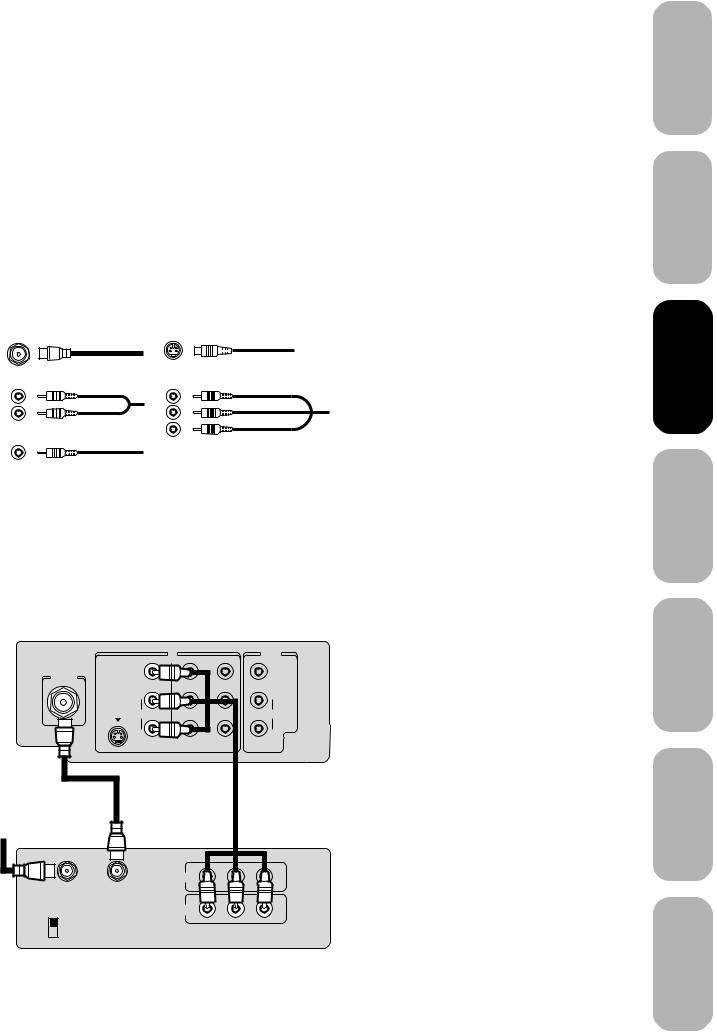
Connecting your TV
If you haven’t connected electronic equipment before, or you have been frustrated in the past, you may wish to read this section. (Cables are not supplied.)
• A coaxial cable is the standard cable that comes in from your |
|
antenna or cable converter box. Coaxial cables use “F” connectors. |
|
• Standard A/V (audio/video) cables are usually color coded |
|
according to use: yellow for video and red and white for audio. The |
|
red audio cable is for the stereo right channel, and the white audio |
|
cable is for the stereo left (or mono) channel. If you look at the rear |
|
panel of the TV, you will see that the terminals are color coded in |
|
the same manner as the cables. |
|
• S-video cables provide better picture performance. S-video cables |
|
can only be used with S-video compatible components. |
Caution: |
• Component video cables come in sets of three and provide the best |
|
picture performance. Component video cables can only be used |
Do not plug the TV in until you have finished |
with component video compatible components. |
connecting all of your equipment. |
S-Video
ANTENNA Cable
Coaxial Cable
AUDIO
Cables
Component video
Cables
VIDEO
Cable
Connecting a VCR
This connection allows you to watch local channels and video programs, play or record on the VCR while watching TV, and record from one channel while watching another channel.
TV
|
IN |
Y |
OUT |
|
|
|
|
VIDEO |
|
VIDEO |
|
ANT (75Ω) |
|
|
|
L/MONO |
PB |
L/MONO |
|
|
|||
S-VIDEO |
AUDIO |
PR |
AUDIO |
|
|
|
|
|
R |
|
R |
|
VIDEO 1 |
VIDEO 2 |
|
Cable Lead-in from cable box
or antenna
Stereo VCR
|
IN |
|
|
IN from ANT |
OUT to TV |
|
|
|
OUT |
|
|
CH 3 |
L |
R |
|
CH 4 |
|||
VIDEO |
AUDIO |
||
|
7
You will need:
•two coaxial cables
•one set of standard A/V cables
Note:
If using a mono VCR, connect L/Mono to VCR Audio OUT using only one audio cable. For better picture quality, if your VCR has S- video, you can use an S-video cable instead of the standard video cable. Do not connect a standard video cable and an S-video cable to VIDEO1 simultaneously.
Safeguards |
Important |
to Welcome
Toshiba
Connecting TV your
the Using
Control Remote
up Setting TV your
TV’s the Using
Features
Appendix

Connecting your TV
Connecting a cable converter box
This television has an extended tuning range and can tune most cable channels without using a cable company supplied converter box. Some cable companies offer "premium pay channels" in which the signal is scrambled. Descrambling these signals for normal viewing requires the use of a descrambler device, which is generally provided by the cable company.
For Subscribers to Basic Cable TV Service
For basic cable service not requiring a Converter/Descrambler box, connect the CATV 75 ohm Coaxial Cable directly to the Antenna Jack on the back of the television.
For Subscribers to Scrambled Cable TV Service
If you subscribe to a cable service that requires the use of a Converter/ Descrambler box, connect the incoming cable to the Converter/ Descrambler box and connect the output of the box to the Antenna Jack on the back of the television. Follow the connections shown below. Set the television to the output of the Converter/Descrambler box (usually channel 3 or 4) and use the Converter/Descrambler box to select channels.
For Subscribers to Unscrambled Basic Cable with Scrambled Premium Channels
If you subscribe to a cable service in which basic cable channels are unscrambled and premium channels require the use of a Converter/ Descrambler box, you may wish to use a two-set signal splitter (sometimes called a "two-set coupler") and an A/B Switch box from the cable installer or an electronics supply store. Follow the connections shown below. With the switch in the "B" position, you can directly tune any nonscrambled channels on your TV. With the switch in the "A" position, tune your TV to the output of the Converter/Descrambler box (usually channel 3 or 4) and use the box to tune scrambled channels.
Incoming CATV
Note:
When you use a converter box with your TV, there may be features that you cannot program using the remote control, such as labeling channels, blocking channels, and programming your favorite channels.
|
IN |
OUT |
|
|
Y |
Converter/Descrambler |
VIDEO |
VIDEO |
ANT (75Ω) |
|
|
|
L/MONO |
PB |
L/MONO |
|
|
|
|
|||
Converter/Descrambler |
S-VIDEO |
AUDIO |
PR |
AUDIO |
|
|
|
|
|||
Splitter |
A / B Switch |
A B |
R |
|
R |
VIDEO 1 |
VIDEO 2 |
|
|||
|
|
|
|
||
8
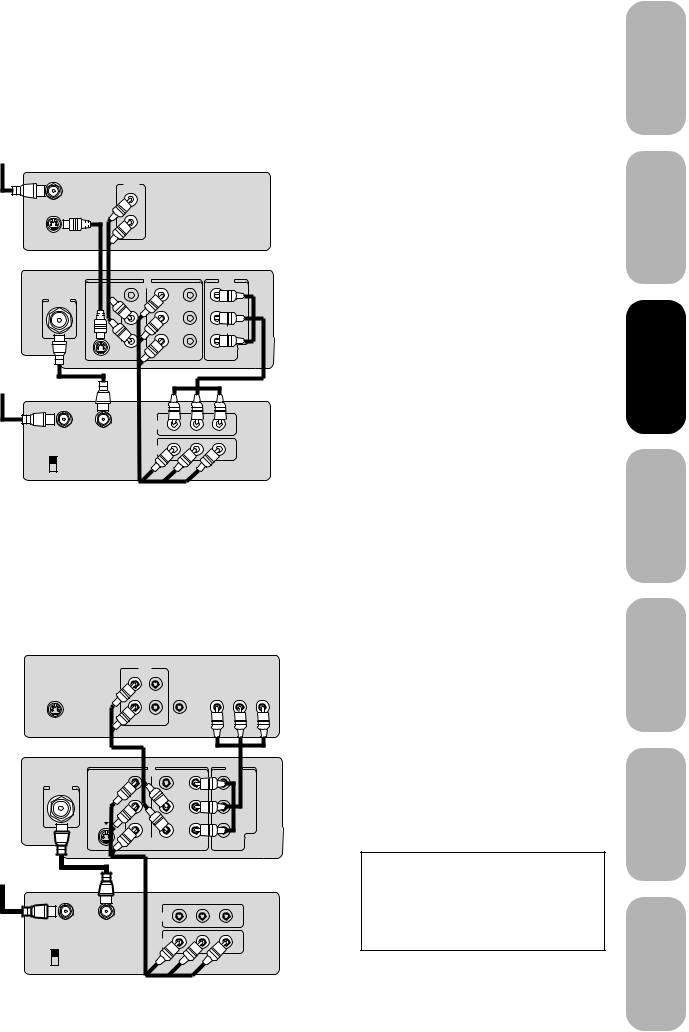
Connecting a DVD player/satellite receiver and a VCR
This connection allows you to watch DVD/satellite, VCR, or TV programs. You can record from the satellite receiver and TV, as well as record one TV channel while watching another channel.
To satellite |
|
|
DVD player / Satellite Receiver |
|
|
OUT |
|
|
L |
|
|
Satellite IN |
|
|
R |
|
|
AUDIO |
|
|
S-VIDEO |
|
|
TV |
|
|
IN |
Y |
OUT |
|
|
|
VIDEO |
|
VIDEO |
ANT (75Ω) |
|
|
L/MONO |
PB |
L/MONO |
|
||
S-VIDEO AUDIO |
PR |
AUDIO |
|
|
|
R |
|
R |
VIDEO 1 |
VIDEO 2 |
|
To antenna
Stereo VCR |
|
|
IN |
IN from ANT |
OUT to TV |
|
OUT |
|
|
CH 3 |
L |
R |
|
CH 4 |
|||
VIDEO |
AUDIO |
||
|
Connecting a DVD player with ColorStream® (component video) and a VCR
This connection allows you to watch DVD, VCR, or TV programs and record TV programs. You can record from one source while watching a program from another source. Your TV is capable of using ColorStream (component video). Connecting your TV to a component video compatible DVD player, such as a Toshiba DVD player with ColorStream®, can greatly enhance picture quality and performance.
DVD player with ColorStream®
OUT
L |
|
|
|
R |
COLORSTREAM TM |
|
|
Y |
Cb |
Cr |
|
AUDIO |
VIDEO |
|
|
S-VIDEO |
OUT |
|
|
TV |
|
|
|
|
IN |
Y |
OUT |
|
|
|
|
VIDEO |
|
VIDEO |
|
ANT (75Ω) |
|
|
|
L/MONO |
PB |
L/MONO |
|
|
|||
S-VIDEO |
AUDIO |
PR |
AUDIO |
|
|
|
|
|
R |
|
R |
|
VIDEO 1 |
VIDEO 2 |
|
To antenna
Stereo VCR |
|
|
|
|
IN |
|
|
IN from ANT |
OUT to TV |
|
|
|
OUT |
|
|
CH 3 |
L |
R |
|
CH 4 |
|||
VIDEO |
AUDIO |
||
|
9
You will need:
•three coaxial cables
•two sets of standard A/V cables
•one S-video cable
•one pair of standard audio cables
Note:
You can use a standard video cable instead of the S-video cable, but the picture quality will decrease. If you use an S-video cable between the TV and DVD player/satellite receiver, make the audio connections only and remove the standard video cable.
You will need:
•two coaxial cables
•one set of standard A/V cables
•one set of component video cables
•one pair of standard audio cables
Note:
The ColorStream inputs on this TV are for use with devices that output 480i interlaced signals ONLY. This TV will not accept or display 480p or 720p progressive scan signals or 1080i interlaced high-definition signals. If you connect a high-definition settop receiver, 480p progressive scan DVD player, or other similar device to the TV’s ColorStream inputs, YOU MUST SWITCH THE DEVICE’S OUTPUT TO 480i INTERLACED MODE FIRST. Failure to do this will cause a poor picture or no picture to display.
The unauthorized recording, use, distribution or revision of television programs, videotapes, DVDs, and other materials is prohibited under the Copyright Laws of the United States and other countries, and may subject you to civil and criminal liability.
Safeguards |
Important |
to Welcome
Toshiba
Connecting TV your
the Using
Control Remote
up Setting TV your
TV’s the Using
Features
Appendix
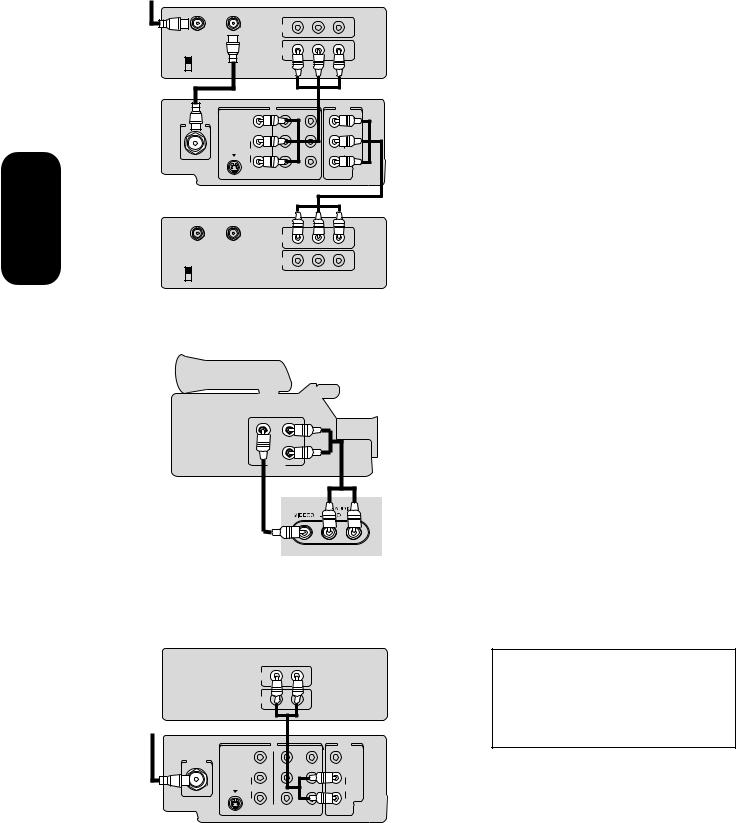
Connecting your TV
Connecting two VCRs
This connection allows you to record (dub/edit) from one VCR to another VCR.
You will also be able to record from one TV channel while watching another channel.
Stereo VCR / Playback
To antenna
|
IN |
|
|
IN from ANT |
OUT to TV |
|
|
|
OUT |
|
|
CH 3 |
L |
R |
|
CH 4 |
|||
VIDEO |
AUDIO |
||
|
TV |
|
|
|
IN |
Y |
OUT |
|
|
|
||
VIDEO |
|
VIDEO |
|
ANT (75Ω) |
|
|
|
L/MONO |
PB |
L/MONO |
|
|
|||
S-VIDEO AUDIO |
PR |
AUDIO |
|
|
|
||
R |
|
R |
|
VIDEO 1 |
VIDEO 2 |
|
|
Stereo VCR / Recording |
|
|
|
IN |
|
|
|
IN from ANT OUT to TV |
|
|
|
OUT |
|
|
|
CH 3 |
L |
R |
|
CH 4 |
|||
VIDEO |
AUDIO |
||
|
Connecting a camcorder
This connection allows you to watch videos recorded on a camcorder.
Camcorder
VIDEO AUDIO
L
R
OUT
Front Panel of TV
You will need:
•two coaxial cables
•two sets of standard A/V cables
Note:
Do not connect the same VCR to the output and input jacks on the TV at the same time. For better picture quality, if your VCR has S- video, you can use an S-video cable instead of the standard video cable. Do not connect a standard video cable and an S-video cable to VIDEO1 simultaneously.
You will need:
• one set of standard A/V cables
Note:
For better picture quality, if your camcorder has S-video, you can connect an S-video (and standard audio cables) to VIDEO1 on the back of the TV. Do not connect a standard video cable and an S-video cable to VIDEO1 simultaneously.
Connecting an audio amplifier
This connection allows you to use an audio amplifier to adjust the audio level. This also allows you to use external speakers.
Audio Amplifier
|
|
AUDIO |
|
|
L |
R |
|
|
IN |
|
|
|
OUT |
|
|
To cable, |
TV |
|
|
IN |
|
OUT |
|
|
Y |
||
cable box |
|
|
|
VIDEO |
|
VIDEO |
|
or antenna |
ANT (75Ω) |
|
|
L/MONO |
PB |
L/MONO |
|
|
|
||
|
S-VIDEO AUDIO |
PR |
AUDIO |
|
|
|
|
|
R |
|
R |
|
VIDEO 1 |
VIDEO 2 |
|
You will need:
•one coaxial cable
•one pair of audio cables
The unauthorized recording, use, distribution or revision of television programs, videotapes, DVDs, and other materials is prohibited under the Copyright Laws of the United States and other countries, and may subject you to civil and criminal liability.
10
